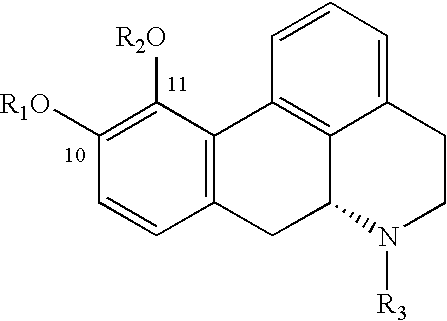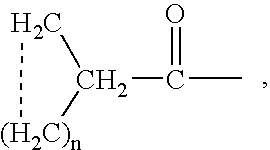Aporphine esters and their use in therapy
a technology of aporphine and esters, which is applied in the direction of biocide, drug composition, aerosol delivery, etc., can solve the problems of increasing difficulty and slow movement, affecting the bioavailability of patients, and affecting the ability of patients to care for themselves, so as to improve the bioavailability
- Summary
- Abstract
- Description
- Claims
- Application Information
AI Technical Summary
Benefits of technology
Problems solved by technology
Method used
Image
Examples
example 1
Mono-Acetyl Apomorphine
[0097]Apomorphine HCl (0.25 g, 0.83 mmol) was dissolved in CH2Cl2 (25 mL) and trifluoroacetic acid (2 mL). The mixture was stirred on ice. Acetyl chloride (0.13 g, 1.65 mmol) was added. The temperature slowly increased to room temperature. The reaction mixture was left overnight, and was then evaporated under reduced pressure, yielding a yellow oil. Purification by column chromatography yielded 17.4 mg (0.056 mmol, 6.8%) of gray crystals. API-MS: m / z 310 (M+H)+.
example 2
Mono-Butyryl Apomorphine
[0098]Apomorphine HCl (0.25 g, 0.83 mmol) was dissolved in CH2Cl2 (25 mL) and trifluoroacetic acid (2 mL). The mixture was stirred on ice. Butyryl chloride (0.09 g, 0.83 mmol) was added. The temperature slowly increased to room temperature. After 3.5 hours, 0.5 equivalents of butyryl chloride was added. Another 0.5 equivalent was added after 5.5 hours. The reaction mixture was left overnight and was then evaporated under reduced pressure, yielding an yellow oil. Purification by column chromatography yielded the product as a colorless oil. Crystallization from hexane yielded 14 mg (0.042 mmol, 5.1%) of gray crystals: mp 99–102° C.; API-MS: m / z 338 (M+H)+.
example 3
Mono-Pivaloyl Apomorphine
[0099]Apomorphine HCl (0.45 g, 1.49 mmol) was dissolved in CH2Cl2 (25 mL) and trifluoro-acetic acid (2 mL). The mixture was stirred on ice. Pivaloyl chloride (0.54 g, 4.46 mmol) was added. The temperature slowly increased to room temperature. The reaction mixture was left overnight, and was then evaporated under reduced pressure, yielding an yellow oil. Purification by column chromatography yielded the product as a colorless oil. Crystallization from hexane yielded 114 mg (0.32 mmol, 21.8%) of gray crystals: mp 128–130° C.; API-MS: m / z 393 (M+).
PUM
| Property | Measurement | Unit |
|---|---|---|
| volume | aaaaa | aaaaa |
| total volume | aaaaa | aaaaa |
| total volume | aaaaa | aaaaa |
Abstract
Description
Claims
Application Information
 Login to View More
Login to View More - R&D
- Intellectual Property
- Life Sciences
- Materials
- Tech Scout
- Unparalleled Data Quality
- Higher Quality Content
- 60% Fewer Hallucinations
Browse by: Latest US Patents, China's latest patents, Technical Efficacy Thesaurus, Application Domain, Technology Topic, Popular Technical Reports.
© 2025 PatSnap. All rights reserved.Legal|Privacy policy|Modern Slavery Act Transparency Statement|Sitemap|About US| Contact US: help@patsnap.com



